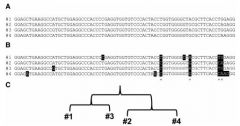Grade Level(s):
- 9-12
- College
Source:
- Lents, Nathan
Resource type:
- lab activity
Discipline:
- Life Science
Time: 1 to 4 class periods or one 3 hour lab session
Overview
Students explore molecular data from Homo sapiens and four related primates and develop multiple hypotheses regarding the ancestry of these five species by analyzing DNA sequences, protein sequences, and chromosomal maps.

- [How science works: Grades 9-12] Scientists test their ideas using multiple lines of evidence. (P6, NOS2)
- [How science works: Grades 9-12] Scientists often try to generate multiple explanations for what they observe. (P7)
- [How science works: Grades 9-12] Different scientists may interpret the same data in different ways. (P7)
- [How science works: Grades 13-16] Scientists test their ideas using multiple lines of evidence.
- [How science works: Grades 13-16] Scientists often try to generate multiple explanations for what they observe.
- [How science works: Grades 13-16] Different scientists may interpret the same data in different ways; data interpretation can be influenced by a scientist's assumptions, biases, and background.
- [The social side of science: Grades 9-12] Science depends on communication within the scientific community. (P7, P8)
- [The social side of science: Grades 9-12] Scientists usually work collaboratively. (NOS7)
- [The social side of science: Grades 13-16] Science depends on communication within the scientific community.
- [The social side of science: Grades 13-16] Scientists usually work collaboratively.
- NOS Matrix understanding category 2. Scientific knowledge is based on empirical evidence.
- NOS Matrix understanding category 7. Science is a human endeavor.
- Science and Engineering Practice 6. Constructing explanations and designing solutions
- Science and Engineering Practice 7. Engaging in argument from evidence
- Science and Engineering Practice 8. Obtaining, evaluating, and communicating information
This lesson illustrates many aspects of the process of science; however, in order to make these points apparent to students, they will need to be explicitly discussed during the class discussion periods.
